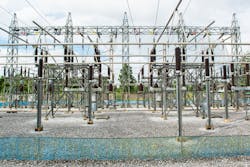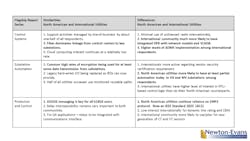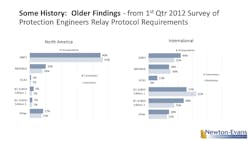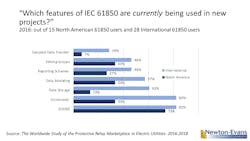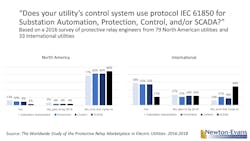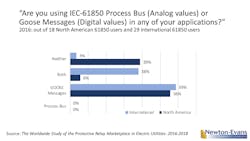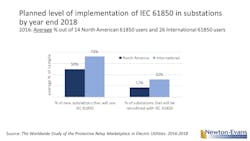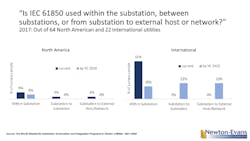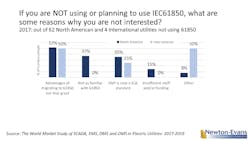Newton-Evans Research Co. began conducting market studies on telecommunication protocols used in multiple control systems end-use markets back in the 1980s. Newton-Evans also keeps in touch with the international community of electric power utilities via its long-term commitment to CIGRE working groups. For over 20 years, the firm has been involved in a number of major working-group-level activities related to substations, protection and control and IEC 61850. The company is currently involved in the updating of D2.46 work on cybersecurity topics and these also relate directly to 61850.
There are multiple approaches to evaluating 61850 and the global electric power grid as it continues to evolve and modernize. For this TDW article, Newton-Evans compared the findings of three of its flagship studies in two categories: North American electric utilities and international electric utilities. There are substantial differences in telecommunication systems design and protocol use based on the maturity of the electric power industry in different parts of the world.
Developing nations can leapfrog over older technology and adopt a 21st century approach to both telecommunications and electric power development, but industrialized countries must continue supporting an older (but still reliable) technology-based approach to grid operations.
Our recent studies and the observations of other market watchers reflect the reality of North America’s power utility structure and grid architecture. We have a relative handful (<30) of very large utilities (millions of customers), a few hundred mid-size utilities and more than 2,000 utilities that each serve fewer than 50,000 customers. These smaller utilities have neither the need for, nor the resources – human and financial – to support a transition from DNP 3 (IEEE 1815) to IEC 61850.
A closer look at three Newton-Evans’s studies provides insights on relay engineers, substation engineers and operation officials from around the world. These studies have reported concerns that more or less mirror each other when it comes to perspectives and outlooks for telecommunications, protective relays, substation modernization and control systems.
As early as 2012, a study by Newton-Evans of Protection & Control topics provided insight from utility engineers in 28 countries. Note the dominance at that time of DNP 3 usage in North America – and a significant use of that protocol internationally as well.
That same 2012 study underscored the preference among early adopter North American utilities for GOOSE messaging. In fact, GOOSE messaging was the most prevalent component of IEC 61850.
In the similar study, question repeated four years later, note the differences between the more recent observations and those reported in 2012. What a difference four years had made.
We obtained additional North American 61850 users in the 2016 study and found a different pattern of usage: more use of each 61850 technical feature among the international community than we had seen till then in North America. Newton-Evans will again be researching similar protective relay and related protocol issues in 2019 and we expect to see additional changes.
Here are some IEC 61850 usage indicators for substation automation, protection and control and SCADA in North America and internationally. There are ongoing variances visible between North American and international respondents as well as sharp differences in overall IEC 61850 usage between these communities.
The following chart compares the percent of utilities surveyed who use Process Bus, GOOSE Messaging, both, or neither. Internationally, the 61850 user base as of 2016 was more likely to be using both Process Bus and GOOSE messaging, while North American users were continuing to rely on GOOSE messaging alone.
Plans for using IEC 61850 for new substations were strong for current users, both internationally and in North America. Users of 61850 in the North American survey indicated 50% of new substations would use 61850, and the International survey showed an average of 73% of new substations would use 61850. Not nearly as strong was the planned use of 61850 for retrofitting the 250,000 transmission and primary distribution substations that were in operation around the world then.
The third study in the series by Newton-Evans was completed in 2017 and was based on surveys of substation engineers. Newton-Evans observed a number of protocols in use for substation telecommunications. The chart below compares usage patterns and plans for adoption of 61850 from the substation engineer’s perspective.
Finally, here are some reasons provided by 2017 survey participants as to why they were not planning to use IEC 61850.
A 2017 Newton-Evans study of operations officials and control center managers seems to indicate that non-users of IEC 61850 do not have a clear picture of the advantages of migrating to the protocol for two key reasons. First, North American utilities, for the most part, are not concerned with IEC standards. Second, the development of an IEEE standard for DNP 3 reinforces the view among operations managers at hundreds of U.S. utilities that it is okay to continue using DNP 3 (IEEE 1815).
The future for IEC 61850 in North America will likely mean:
More North American utilities will begin to use IEC 61850
- Keeping in mind that the majority of utilities are small-medium in size (<50,000 customers)
Usage will expand beyond the pilot stage by 2020 for the largest utilities
Majority of smart substation equipment manufacturers will offer optional IEC 61850-compatible configurations
- Protective relay manufacturers already do, led by SEL in North America
- Manufacturers of DA field equipment also starting to offer this option
Nonetheless, other protocols - led by DNP 3 - will remain in use for the foreseeable future and will provide workable alternatives for substation modernization and the digital substation as well
- Proven for decades in use throughout the entire energy pipeline from energy production through final distribution
The protective relay study planned by Newton-Evans for early 2019 will once again explore similar questions regarding adoption of IEC 61850 at the world’s utilities.
About the Author
Charles W. Newton
President
Charles W. Newton is the president of Newton-Evans Research Co. He has been a 40-year career-long electric power industry researcher of information technology and infrastructure products, markets, and trends.
